UNC Charlotte Autonomous Shuttle Pilot Study: An Assessment of Operational Performance, Reliability, and Challenges
Abstract
:1. Introduction
2. Operational Overview and Data Methodology
2.1. Route Description
2.2. Shuttle’s Specifications
2.3. Data Collection
2.3.1. Autonomy Disengagement Data Collection
- Technical and Signal Issues refers to disengagements resulting from technical faults or signal problems. The specific causes of disengagement within this group are as follows:
- –
- Fault Code/Error Code: The shuttle encountered a fault or error code that prevented autonomous operation, prompting the shuttle operator to take manual control to navigate to the next safe stop location.
- –
- Signal Loss: The shuttle lost its 3G/GNSS/RTK signal, making it unable to continue in automated mode. The shuttle operator navigated manually until the signal was restored, then resumed automated mode.
- –
- Signalized Intersection: The shuttle operator manually navigated through a signalized intersection to avoid stopping at a green light and proceeded to the next safe stop location for troubleshooting.
- Safety and Interaction with Other Road Users refers to disengagements related to safety concerns and interactions with other road users, emphasizing the need for careful navigation in dynamic and unpredictable environments. The specific causes of disengagement within this group are as follows:
- –
- Other Road Users: A nearby vehicle was detected as an obstacle, causing the shuttle to switch to manual mode. The shuttle’s operator manually navigated around the vehicle and then returned to automated mode.
- –
- Blocked Station: The shuttle station was blocked, preventing autonomous operation into or out of the designated stop. The shuttle operator navigated manually to stop and then resumed automated mode.
- –
- Vulnerable Road Users: This includes cases involving children, elderly, or disabled individuals where manual control was necessary for safety.
- –
- Safety In/Out: This refers to situations where the shuttle encountered issues either while starting or completing its stop at a station. For instance, a “Safety Out” disengagement would occur if the shuttle faced challenges while departing from a station. Conversely, a “Safety In” disengagement would be recorded if there were difficulties when the shuttle arrived and stopped at a station.
- Environmental Factors refers to disengagements due to environmental conditions that affected the shuttle’s ability to operate autonomously. The specific causes of disengagement within this group are as follows:
- –
- Vegetation: Vegetation obstructed the shuttle’s path, preventing automated operation.
- –
- Obstacle Detection: An obstacle was detected in the shuttle’s path, preventing autonomous operation. The shuttle operator navigated around the obstacle in manual mode and then returned to automated mode.
- –
- Weather Conditions: Weather-related disengagements occur under adverse conditions like heavy rain or fog, which compromise the vehicle’s sensors and autonomous functions.
- Navigation and Path Deviation refers to disengagements caused by navigation errors or deviations from the approved route. The specific causes of disengagement within this group are as follows:
- –
- Priority Zone. An object, pedestrian, or vehicle was detected within a priority zone, halting autonomous operation. The shuttle operator manually navigated around the obstacle and then returned to automated mode.
- –
- Shuttle Manually Deviated from Approved Path: The shuttle operator manually operated the shuttle outside the National Highway Traffic Safety Administration (NHTSA) approved path.
2.3.2. Operational Efficiency Data Collection
- Service Reliability refers to the shuttle’s ability to operate according to its schedule. The key metrics used to evaluate service reliability include the following:
- –
- Suspension of Service captures periods when service operations were halted, providing context for any operational interruptions.
- –
- Scheduled and Operational Hours track the planned versus actual operational time of the shuttle, providing a measure of service consistency.
- –
- Uptime Percentage indicates the proportion of scheduled hours during which the shuttle remained operational, serving as a key indicator of reliability.
- Service Usage refers to the overall utilization of the shuttle service. The key metrics used to evaluate usage include the following:
- –
- Number of Round Trips Completed provides insight into service operational throughput.
- –
- Number of Passengers helps assess the shuttle’s usage and capacity.
- –
- Number of Passengers per Hour Operated provides insight to service demand and shuttle efficiency.
- –
- Number of Passengers per Round Trip provides insight into shuttle occupancy levels.
- –
- Number of Round Trips per Hour Operated offers a measure of operational efficiency.
- Service Performance evaluates the shuttle’s operational performance. The key metrics include the following:
- –
- Average and Maximum Vehicle Speeds measure the typical and peak speeds achieved daily, which are essential for evaluating the shuttle’s efficiency.
- –
- Autonomous Mode Percentage reflects the percentage of time the shuttle operated autonomously, providing insights into the shuttle’s capabilities and performance under various conditions.
- –
- Starting and Ending Battery Percentage measures the battery levels at the start and end of each operational period; these measurements are used to assess energy consumption.
- –
- Battery Percentage Used measures the difference between starting and ending battery percentages, providing insight into energy efficiency.
2.4. Data Processing
3. Analysis and Results
3.1. Service Robustness: Autonomy Disengagement Analysis
3.2. Service Reliability: Suspension Events, Operational Hours, and Uptime
3.2.1. Temporal Variation in Service Suspension
3.2.2. Scheduled vs. Operated Hours and Uptime Analysis
3.3. Service Usage: Number of Passengers and Trips
3.3.1. Number of Completed Round Trips
3.3.2. Number of Passengers
3.4. Service Performance: Speed and Autonomy Metrics
3.4.1. Average Speed and Maximum Speed
3.4.2. Percent Autonomy
3.5. Service Battery Performance
4. Conclusions and Recommendations
Author Contributions
Funding
Data Availability Statement
Acknowledgments
Conflicts of Interest
References
- Diba, D.S.; Gore, N.; Pulugurtha, S.S. Autonomous Shuttle Implementation and Best Practices; Mineta Transportation Institute: San Jose, CA, USA, 2023. [Google Scholar]
- Shaheen, S.; Cohen, A. Mobility on Demand in the United States: From Operational Concepts and Definitions to Early Pilot Projects and Future Automation; Springer: Berlin/Heidelberg, Germany, 2020. [Google Scholar]
- Gurumurthy, K.M.; Kockelman, K.M.; Zuniga-Garcia, N. First-mile-last-mile collector-distributor system using shared autonomous mobility. Transp. Res. Rec. 2020, 2674, 638–647. [Google Scholar] [CrossRef]
- Abotalebi, E.; Petrunić, J. New Mobility and Autonomous Vehicles. 2021. Available online: https://cutric-crituc.org/wp-content/uploads/2022/03/New-Mobility-and-Autonomous-Vehicles-Impacts-on-Greenhouse-Gas-Emissions-in-Metro-Vancouver.pdf (accessed on 10 October 2024).
- Pulugurtha, S. Operational and Policy-Related Data Assessment and Recommendations from Review-based Analysis of Autonomous Shuttle Deployments. Transp. Dev. Res. 2024, 2, 1–14. [Google Scholar] [CrossRef]
- Cregger, J.; Mahavier, K.; Holub, A.; Machek, E.; Crayton, T.; Patel, R.; Suder, S. Brothers National Memorial; Technical Report; John A. Volpe National Transportation Systems Center (US): Cambridge, MA, USA, 2022.
- Sheriff, S.M. Reclaiming Urban Spaces: A Pedestrian-Oriented Multi-Modal Transportation System That Implements Autonomous Vehicles to Improve the Quality of Life in Waikiki. Ph.D. Thesis, University of Hawai’i at Manoa, Honolulu, HI, USA, 2020. [Google Scholar]
- Zubin, I.; van Oort, N.; van Binsbergen, A.; van Arem, B. Adoption of shared automated vehicles as access and egress mode of public transport: A research agenda. In Proceedings of the 2020 IEEE 23rd International Conference on Intelligent Transportation Systems (ITSC), Rhodes, Greece, 20–23 September 2020; pp. 1–6. [Google Scholar]
- Self-Driving Shuttle for Passenger Transportation. 2023. Available online: https://www.navya.tech/en/solutions/moving-people/self-driving-shuttle-for-passenger-transportation/ (accessed on 10 October 2024).
- Clancy, J. Breakdowns in Human-AI Partnership: Revelatory Cases of Automation Bias in Autonomous Vehicle Accidents. 2019. Available online: https://cdr.lib.unc.edu/concern/masters_papers/d791sm69k (accessed on 10 October 2024).
- Feys, M.; Rombaut, E.; Macharis, C.; Vanhaverbeke, L. Understanding stakeholders’ evaluation of autonomous vehicle services complementing public transport in an urban context. In Proceedings of the 2020 Forum on Integrated and Sustainable Transportation Systems (FISTS), Delft, The Netherlands, 3–5 November 2020; pp. 341–346. [Google Scholar]
- Herrmann, A.; Brenner, W.; Stadler, R. Stakeholders. In Autonomous Driving; Emerald Publishing Limited: Bradford, UK, 2018; pp. 171–178. [Google Scholar]
- Bucchiarone, A.; Battisti, S.; Marconi, A.; Maldacea, R.; Ponce, D.C. Autonomous shuttle-as-a-service (ASaaS): Challenges, opportunities, and social implications. IEEE Trans. Intell. Transp. Syst. 2020, 22, 3790–3799. [Google Scholar] [CrossRef]
- Zimbron-Alva, M. Autonomous Vehicles: Introducing a New Actor in the Market; London School of Economics and Political Science: London, UK, 2016. [Google Scholar]
- Embracing the Future of Transportation with Autonomous Vehicle Testing. 2018. Available online: https://www.calgary.ca/major-projects/smart-city/autonomous-vehicle.html (accessed on 10 October 2024).
- City of Beaumont Autonomous Shuttle Pilot Project-Report to Public. 2019. Available online: https://issuu.com/beaumont-alberta/docs/09402-19-ela-report-dfinv3 (accessed on 10 October 2024).
- Alphaba Smart Bus. 2017. Available online: https://space.uitp.org/initiatives/alphaba-smart-bus-av-pilot-shenzhen-china (accessed on 17 February 2023).
- Huiling, E.; Goh, B. AI, robotics and mobility as a service: The case of Singapore. Field Actions Sci. Rep. J. Field Actions 2017, 17, 26–29. [Google Scholar]
- Van der Wiel, J.W. Automated shuttles on public roads: Lessons learned. In Proceedings of the ITS European Congress, Strassbourg, France, 18–22 June 2017. [Google Scholar]
- Tajitsu, N. Japan trials driverless cars in bid to keep rural elderly on the move. REtrieved March 2017, 21, 2018. [Google Scholar]
- Iclodean, C.; Varga, B.O.; Cordoș, N. Social Implication. In Autonomous Vehicles for Public Transportation; Springer: Berlin/Heidelberg, Germany, 2022; pp. 413–437. [Google Scholar]
- Haque, A.M.; Brakewood, C. A synthesis and comparison of American automated shuttle pilot projects. Case Stud. Transp. Policy 2020, 8, 928–937. [Google Scholar] [CrossRef]
- Alessandrini, A. (Ed.) Chapter 5—ARTS Certification and Legal Framework. In Implementing Automated Road Transport Systems in Urban Settings; Elsevier: Amsterdam, The Netherlands, 2018; pp. 265–293. [Google Scholar] [CrossRef]
- Peng, H.; McCarthy, R. Mcity ABC Test. 2019. Available online: https://mcity.umich.edu/wp-content/uploads/2019/01/mcity-whitepaper-ABC-test.pdf (accessed on 10 October 2024).
- Chinen, K.; Matsumoto, M.; Chinen, A. Navigating the Landscape of Autonomous Buses: Insights in Ibaraki, Japan. Sustainability 2024, 16, 3351. [Google Scholar] [CrossRef]
- Searcy, S.; Curran, S. Connected Autonomous Shuttle Supporting Innovation (CASSI) in Cary’s Bond Park. 2023. Available online: https://rosap.ntl.bts.gov/view/dot/73005 (accessed on 10 October 2024).
- North Carolina Department of Transportation; IMD. Connected Autonomous Shuttle Supporting Innovation (CASSI). Available online: www.ncdot.gov/divisions/integrated-mobility/innovation/cassi/Pages/default.aspx (accessed on 20 September 2024).
- Iclodean, C.; Cordos, N.; Varga, B.O. Autonomous shuttle bus for public transportation: A review. Energies 2020, 13, 2917. [Google Scholar] [CrossRef]
- Instruments, T. Advanced Driver Assistance (ADAS) Solutions Guide; Technical Report; Texas Instruments: Dallas, TX, USA, 2015. [Google Scholar]
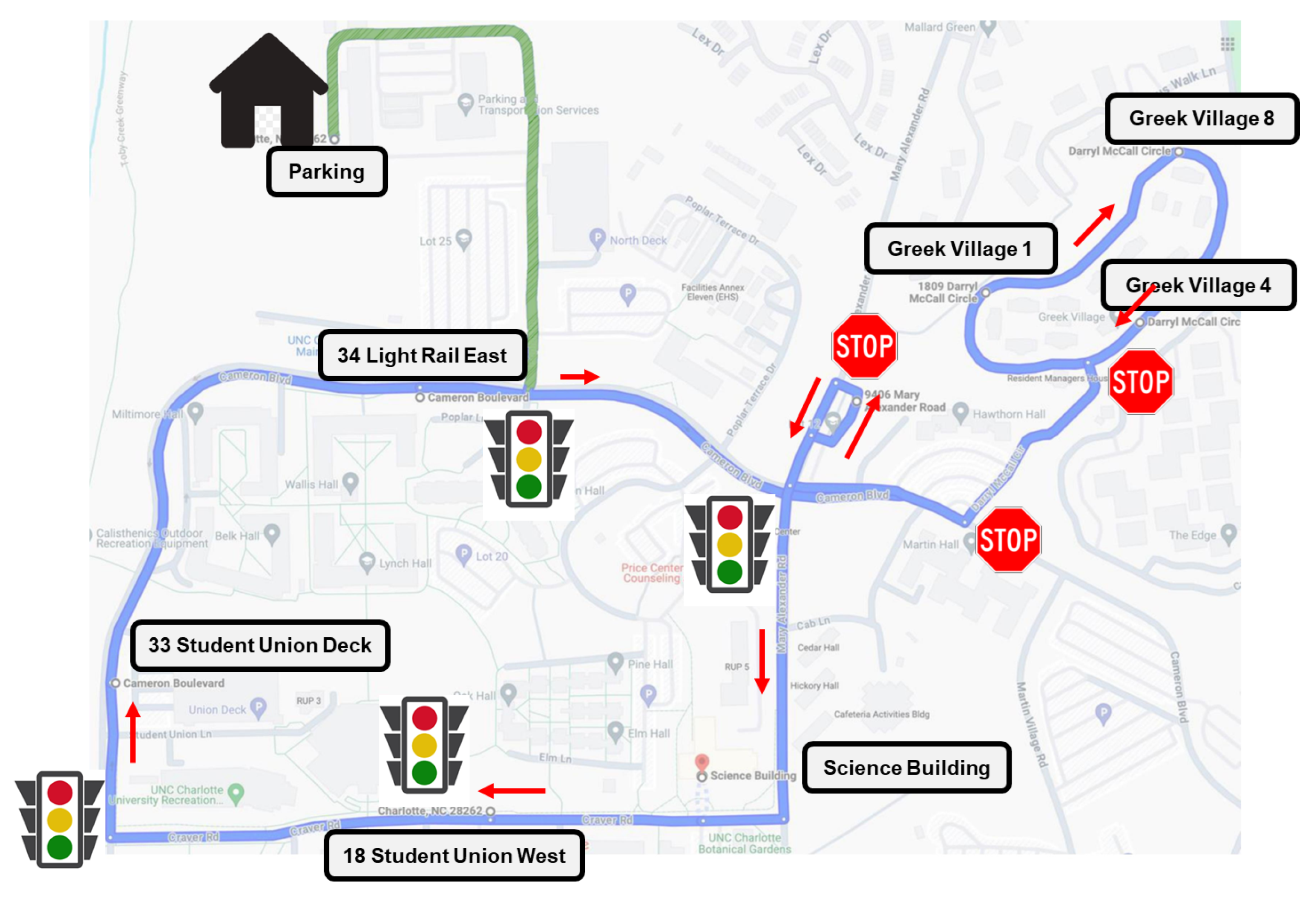
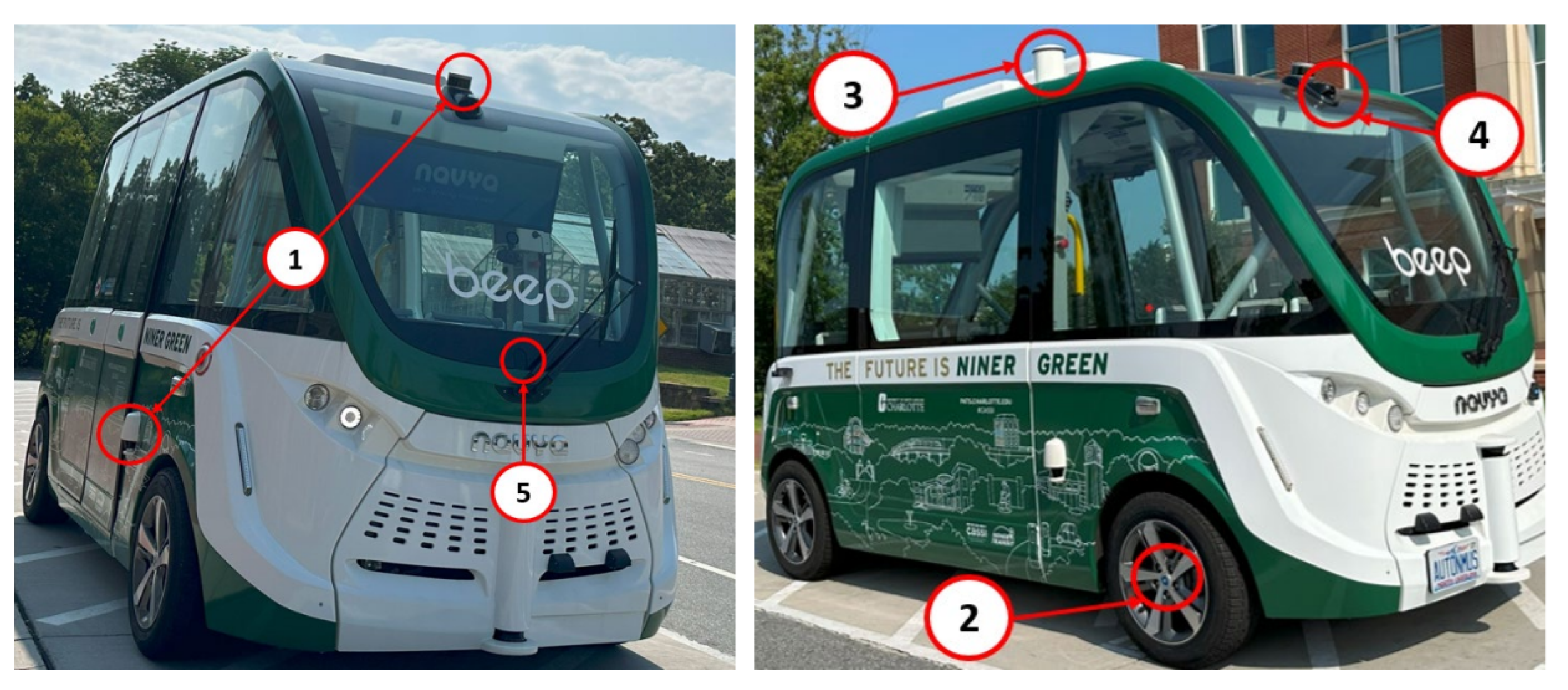
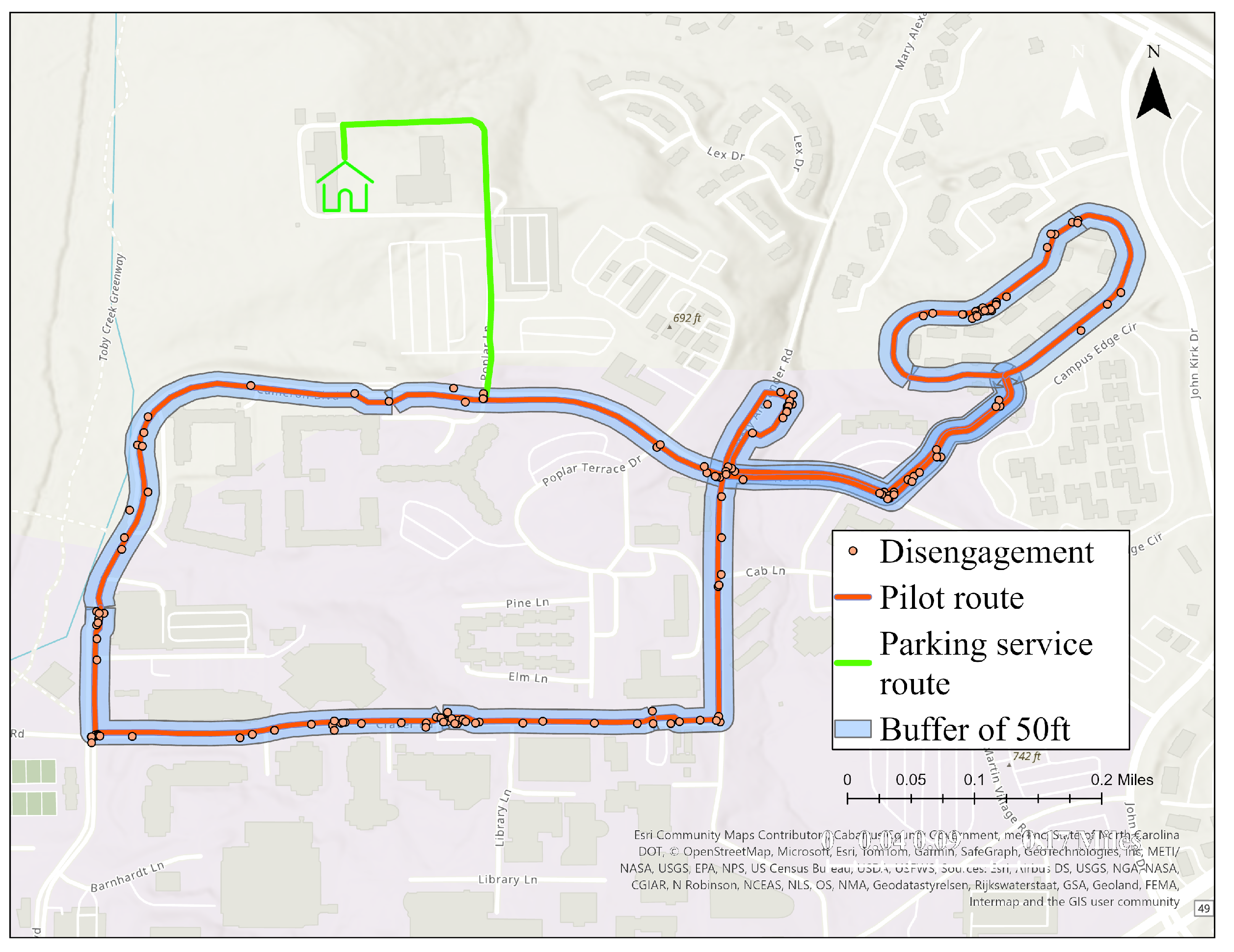

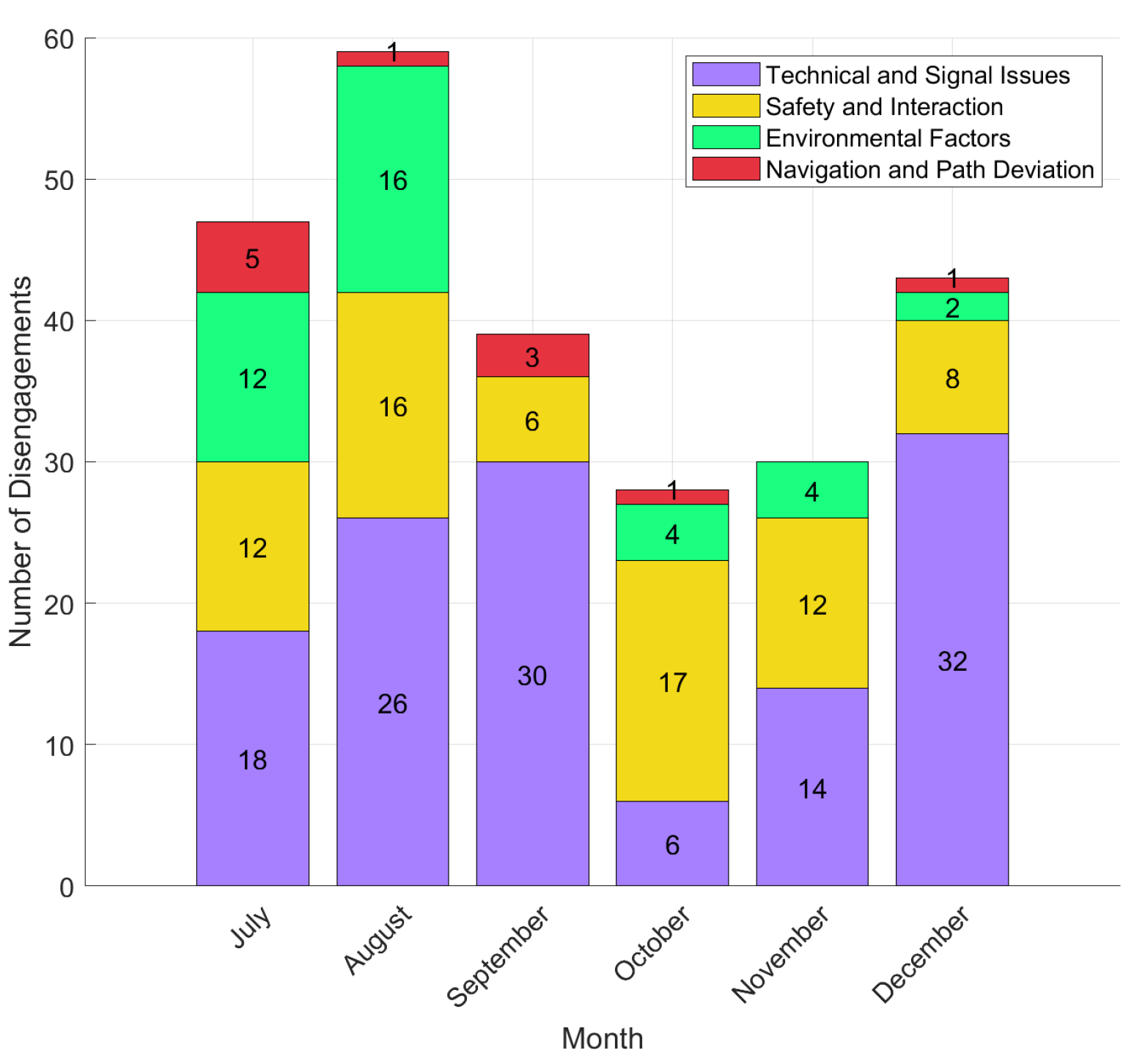
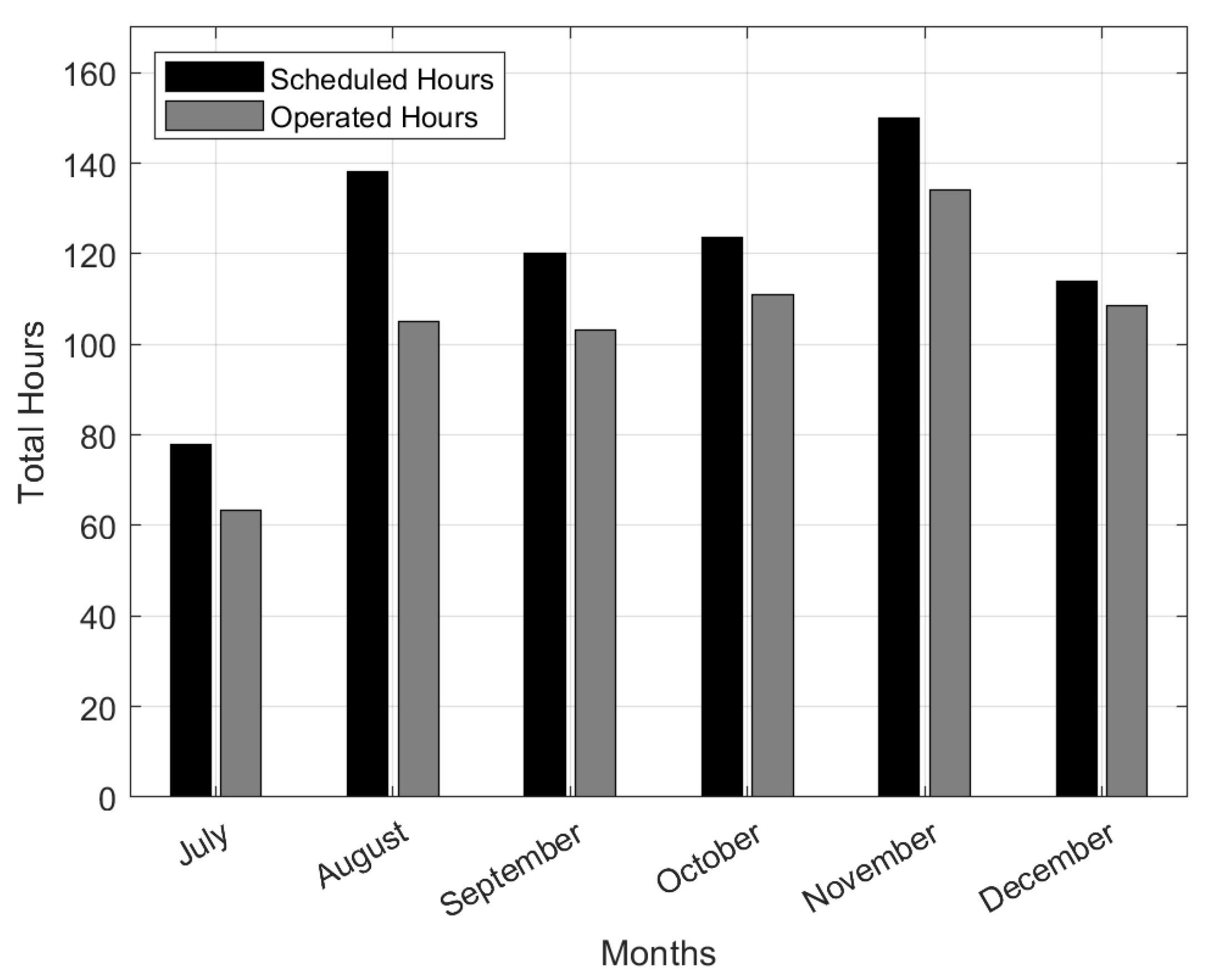
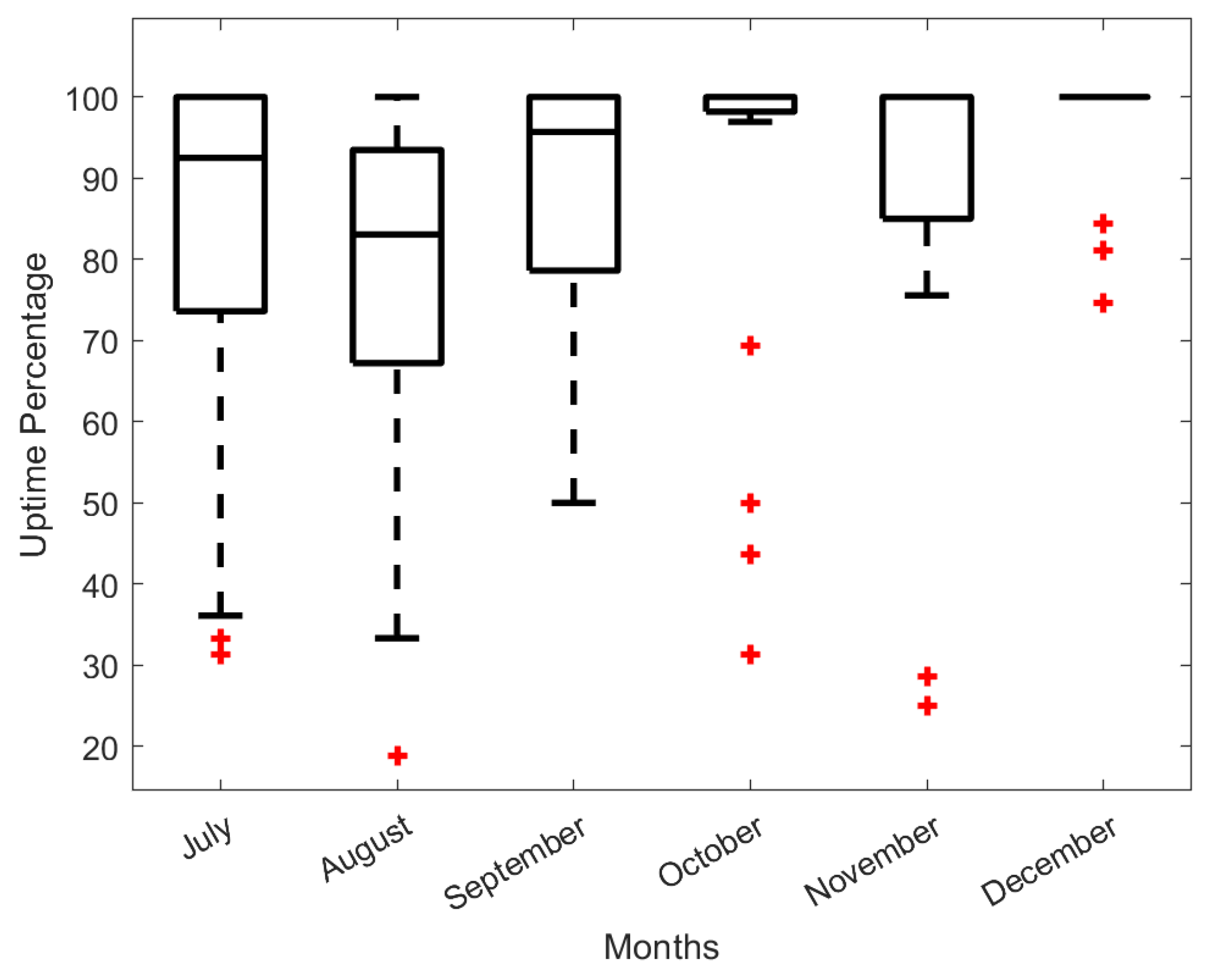
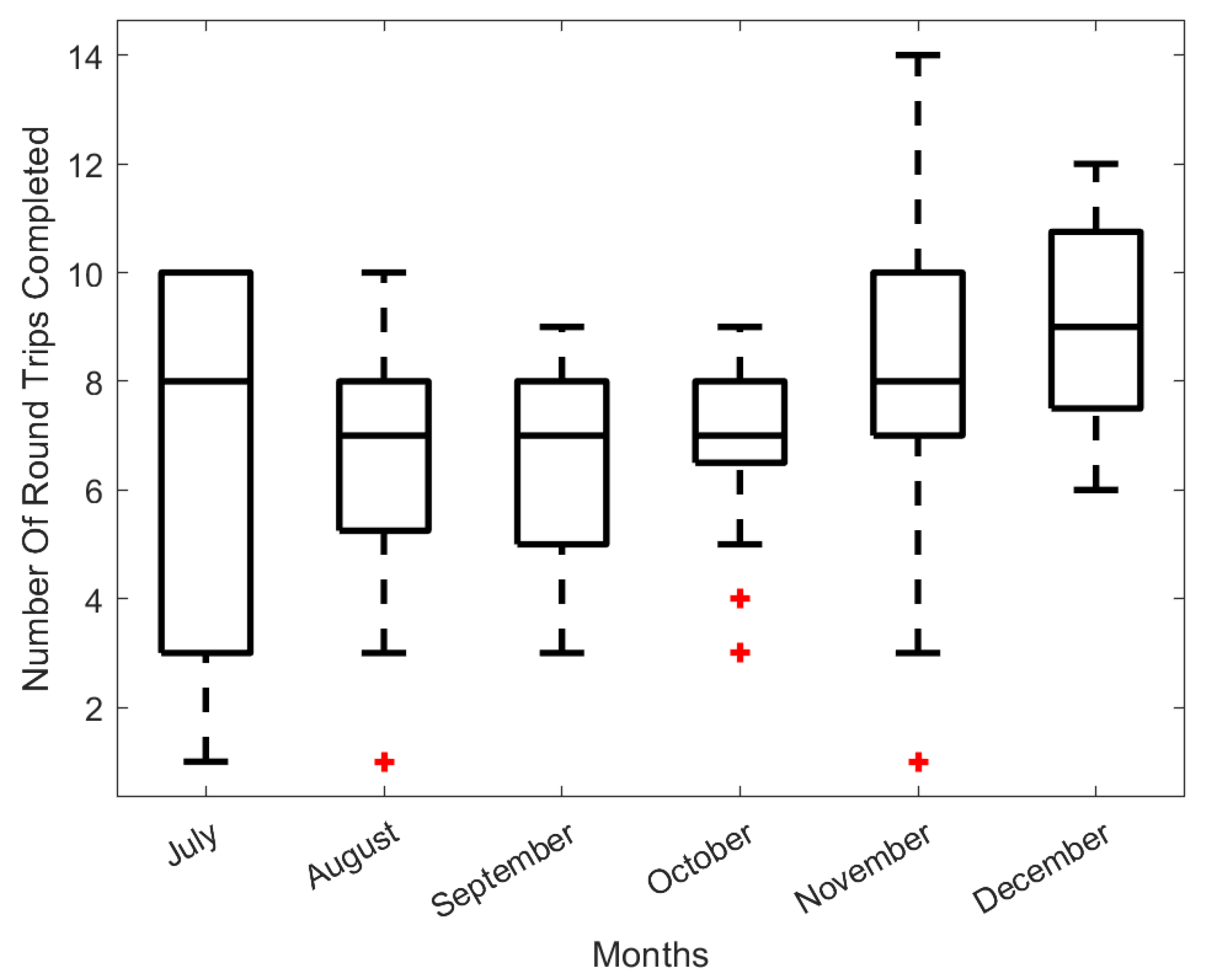
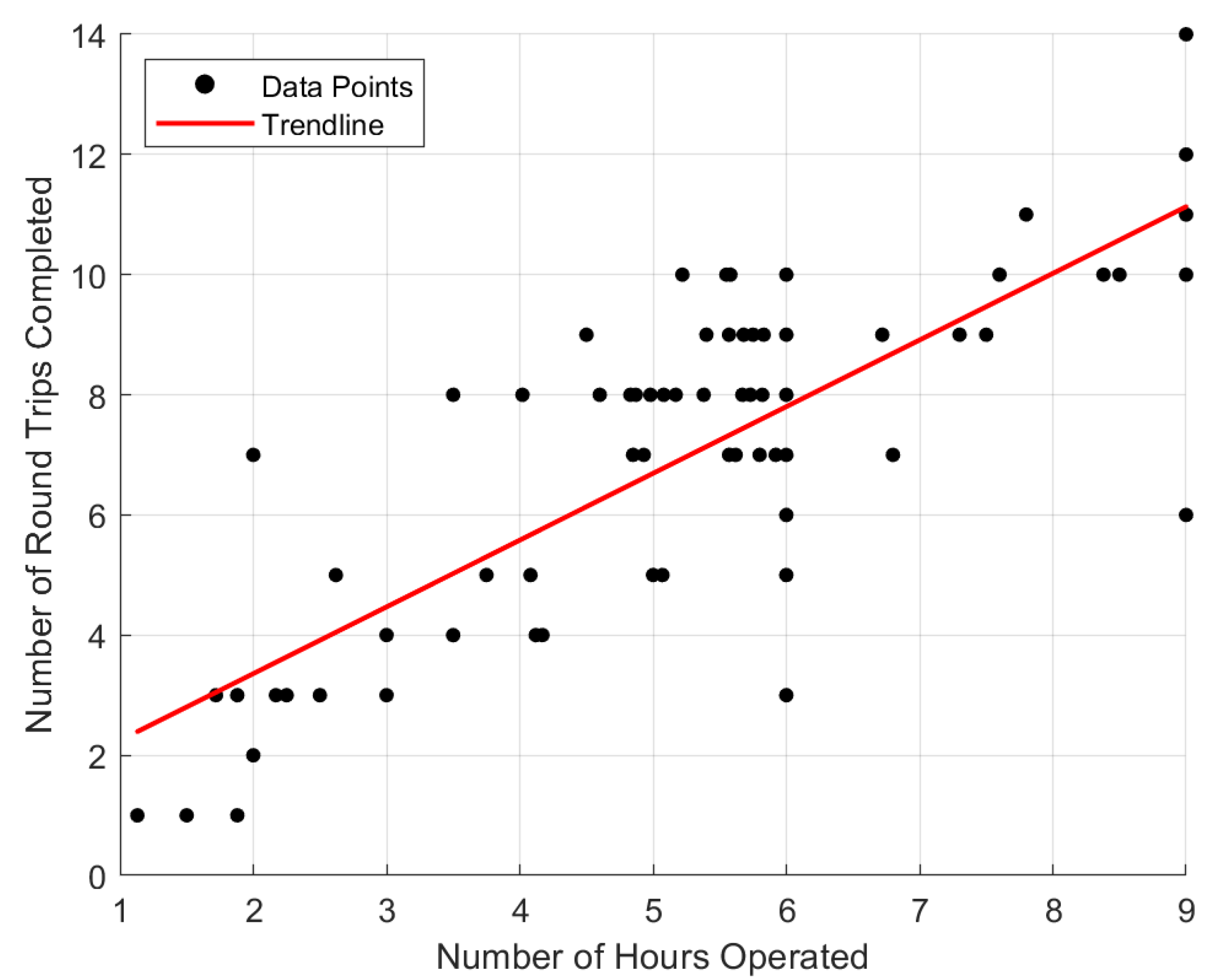
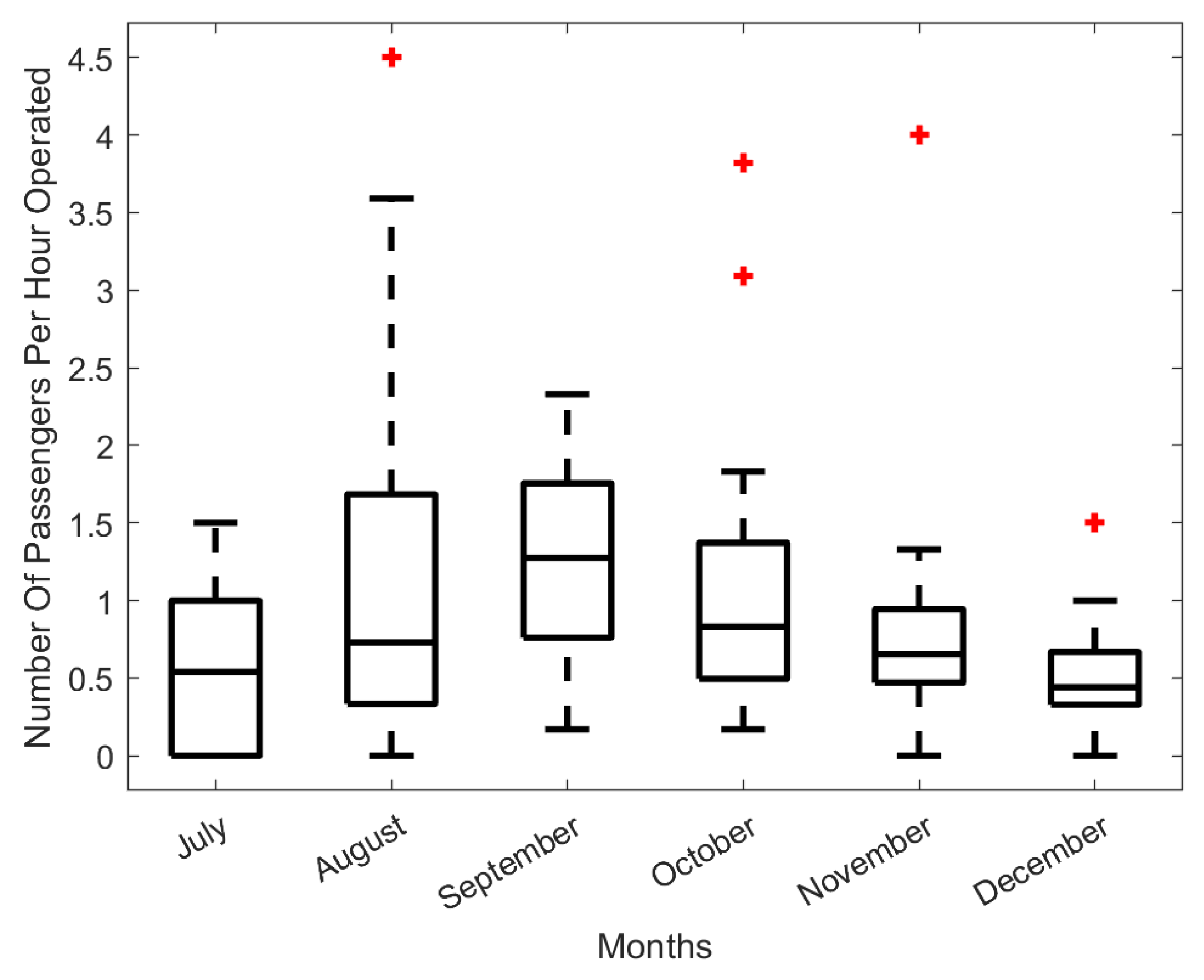
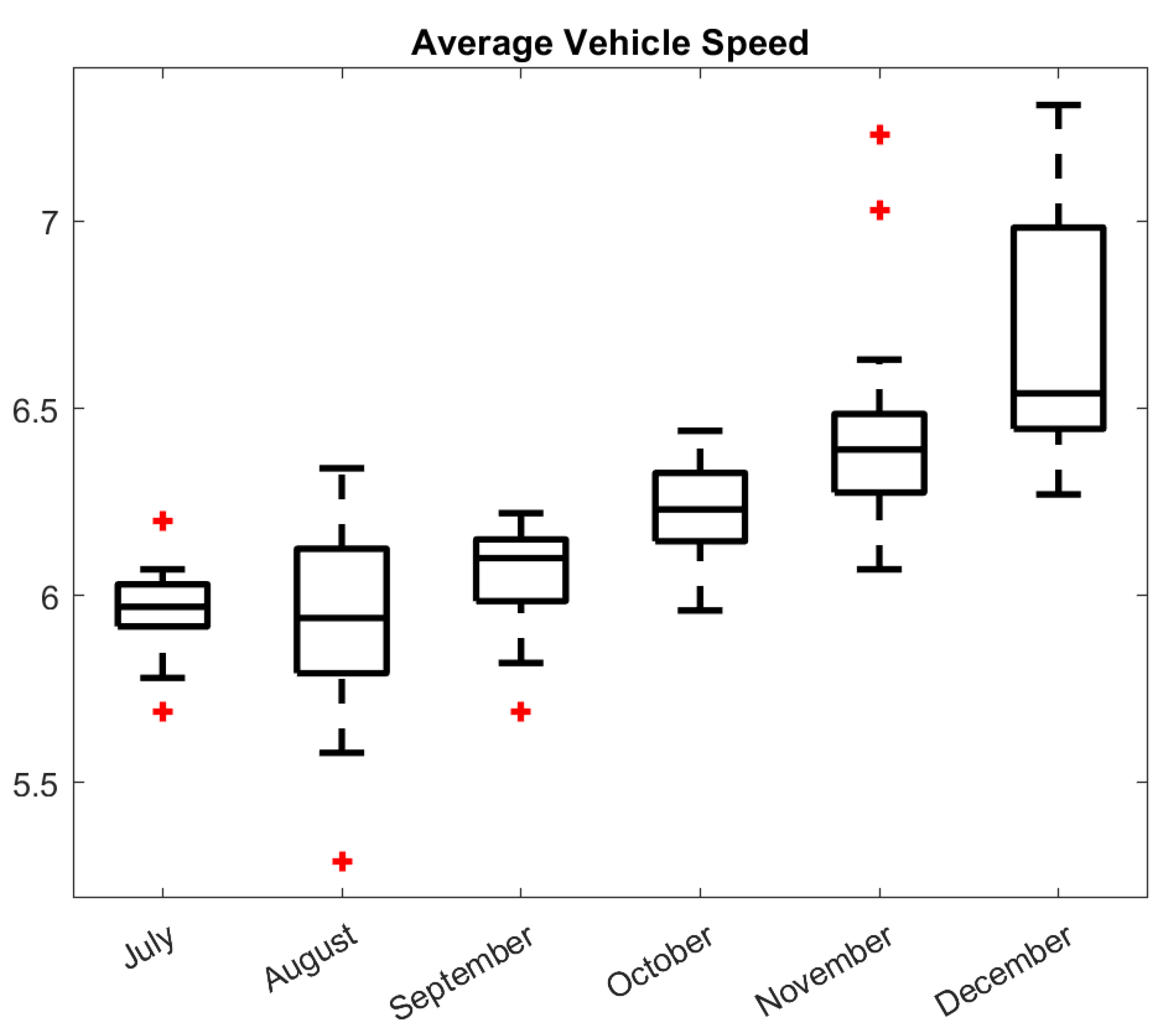



| Segment | Category | July | Aug. | Sep. | Oct. | Nov. | Dec. | Total |
|---|---|---|---|---|---|---|---|---|
| 18 Student Union West–33 Student Union Deck | Environmental factors | - | - | - | 1 | 1 | 1 | 3 |
| Navigation and path deviation | - | 1 | - | - | - | - | 1 | |
| Safety and interaction with others | 3 | - | 3 | 4 | 2 | 3 | 15 | |
| Technical and signal issues | 13 | 8 | 9 | 6 | 3 | 24 | 63 | |
| Segment total | 16 | 9 | 12 | 11 | 6 | 28 | 82 | |
| 33 Student Union Deck–34 Light Rail East | Environmental factors | - | 3 | - | - | - | 1 | 4 |
| Safety and interaction with others | 1 | 1 | - | - | - | 1 | 3 | |
| Technical and signal issues | - | - | - | - | - | 3 | 3 | |
| Segment total | 1 | 4 | - | - | - | 5 | 10 | |
| 34 Light Rail East–Greek Village 4 | Environmental factors | 1 | - | - | - | 1 | - | 2 |
| Safety and interaction with others | - | - | - | 1 | - | - | 1 | |
| Technical and signal issues | 1 | 3 | 7 | - | 7 | 2 | 20 | |
| Segment total | 2 | 3 | 7 | 1 | 8 | 2 | 23 | |
| Greek Village 1–Greek Village 8 | Environmental factors | 1 | 11 | - | 1 | - | - | 13 |
| Safety and interaction with others | 1 | 11 | - | 2 | 1 | - | 15 | |
| Technical and signal issues | 1 | - | 1 | - | - | - | 2 | |
| Segment total | 3 | 22 | 1 | 3 | 1 | - | 30 | |
| Greek Village 4–Science Building | Environmental factors | 5 | 2 | - | 2 | 1 | - | 10 |
| Navigation and path deviation | 5 | - | 3 | 1 | - | 1 | 10 | |
| Safety and interaction with others | 2 | 3 | 3 | 7 | 4 | 3 | 22 | |
| Technical and signal issues | 2 | 15 | 12 | - | 4 | 3 | 36 | |
| Segment total | 14 | 20 | 18 | 10 | 9 | 7 | 78 | |
| Greek Village 8–Greek Village 4 | Environmental factors | - | - | - | - | 1 | - | 1 |
| Safety and interaction with others | - | - | - | 1 | - | 1 | 2 | |
| Segment total | - | - | - | 1 | 1 | 1 | 3 | |
| Science Building–18 Student Union West | Environmental factors | 5 | - | - | - | - | - | 5 |
| Safety and interaction with others | 5 | 1 | - | 2 | 3 | - | 11 | |
| Technical and signal issues | 1 | - | 1 | - | - | - | 2 | |
| Segment total | 11 | 1 | 1 | 2 | 3 | - | 18 | |
| Total | 47 | 59 | 39 | 28 | 28 | 43 | 244 |
| Category | Reason for Suspension | July | Aug. | Sep. | Oct. | Nov. | Dec. | Total |
|---|---|---|---|---|---|---|---|---|
| Attendant-Related Issues | Attendant attended mandatory training from Navya | - | - | - | - | 1 | - | 1 |
| Attendant required to upload footage from incident that occurred overnight | - | - | - | - | 1 | - | 1 | |
| Attendant unable to complete shift due to illness | - | - | - | - | 1 | - | 1 | |
| Attendant was late for start of shift | - | - | 1 | - | - | - | 1 | |
| Technical and Equipment Issues | Charger not working | - | - | 1 | - | - | - | 1 |
| Controller reset | 1 | 1 | - | - | - | - | 2 | |
| GNSS signal loss and troubleshooting | 3 | 5 | 3 | 3 | 1 | 2 | 17 | |
| GNSS signal loss and troubleshooting; inclement weather | - | 1 | - | - | - | - | 1 | |
| GNSS signal loss and troubleshooting; insufficient battery | - | - | 1 | - | - | - | 1 | |
| Insufficient battery | 3 | 9 | 3 | - | 1 | - | 16 | |
| Motor bracket needed repair | - | - | 1 | 1 | - | - | 2 | |
| Motor bracket repaired by midday | - | - | - | 1 | - | - | 1 | |
| Navya was connected to vehicle at the start of shift | - | - | 1 | - | - | - | 1 | |
| Navya was connected to vehicle at the start of shift; GNSS signal loss and troubleshooting | - | - | 1 | - | - | - | 1 | |
| Vehicle did not charge after previous shift due to broken outlet | 1 | - | - | - | - | - | 1 | |
| Environmental and External Factors | Inclement weather | - | 4 | - | 2 | 2 | 1 | 9 |
| No service after 2 PM due to home football game | - | - | - | 1 | - | - | 1 | |
| Time needed to install equipment on vehicle for environmental data collection exceeded the charging break | - | - | - | - | 1 | - | 1 | |
| Total | 8 | 20 | 12 | 8 | 8 | 3 | 59 |
| Month | Number of Service Suspensions | Number of Disengagements | Average Uptime Percentage | ||||
|---|---|---|---|---|---|---|---|
| Enviromental Factors | Navigation and Path Deviation | Safety and Interaction with Others | Technical and Signal Issues | Total | |||
| July | 8 | 12 | 5 | 12 | 18 | 47 | 81.24 |
| August | 20 | 16 | 1 | 16 | 26 | 59 | 76.17 |
| September | 12 | 0 | 3 | 6 | 30 | 39 | 86.08 |
| October | 8 | 4 | 1 | 17 | 6 | 28 | 90.00 |
| November | 8 | 4 | 0 | 10 | 14 | 28 | 88.38 |
| December | 3 | 2 | 1 | 8 | 32 | 43 | 96.01 |
| July | August | September | October | November | |
|---|---|---|---|---|---|
| Number of Round Trips | 85 | 156 | 133 | 144 | 166 |
| Number of Passengers | 44 | 110 | 129 | 112 | 113 |
| Disengagement Type | Correlation with Percent Autonomy | p-Value |
|---|---|---|
| Environmental Factors | −0.08 | 0.40 |
| Navigation and Path Deviation | 0.01 | 0.88 |
| Safety and Interaction with Others | 0.10 | 0.31 |
| Technical and Signal Issues | −0.49 | <0.05 |
| Total | −0.36 | <0.05 |
Disclaimer/Publisher’s Note: The statements, opinions and data contained in all publications are solely those of the individual author(s) and contributor(s) and not of MDPI and/or the editor(s). MDPI and/or the editor(s) disclaim responsibility for any injury to people or property resulting from any ideas, methods, instructions or products referred to in the content. |
© 2024 by the authors. Licensee MDPI, Basel, Switzerland. This article is an open access article distributed under the terms and conditions of the Creative Commons Attribution (CC BY) license (https://creativecommons.org/licenses/by/4.0/).
Share and Cite
Golchin, M.; Grandhi, A.; Gore, N.; Pulugurtha, S.S.; Ghasemi, A. UNC Charlotte Autonomous Shuttle Pilot Study: An Assessment of Operational Performance, Reliability, and Challenges. Machines 2024, 12, 796. https://doi.org/10.3390/machines12110796
Golchin M, Grandhi A, Gore N, Pulugurtha SS, Ghasemi A. UNC Charlotte Autonomous Shuttle Pilot Study: An Assessment of Operational Performance, Reliability, and Challenges. Machines. 2024; 12(11):796. https://doi.org/10.3390/machines12110796
Chicago/Turabian StyleGolchin, Mohammadnavid, Abhinav Grandhi, Ninad Gore, Srinivas S. Pulugurtha, and Amirhossein Ghasemi. 2024. "UNC Charlotte Autonomous Shuttle Pilot Study: An Assessment of Operational Performance, Reliability, and Challenges" Machines 12, no. 11: 796. https://doi.org/10.3390/machines12110796
APA StyleGolchin, M., Grandhi, A., Gore, N., Pulugurtha, S. S., & Ghasemi, A. (2024). UNC Charlotte Autonomous Shuttle Pilot Study: An Assessment of Operational Performance, Reliability, and Challenges. Machines, 12(11), 796. https://doi.org/10.3390/machines12110796






